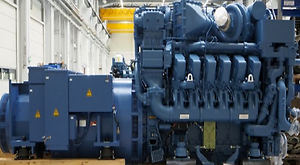Simulation tests of a VCR engine as a propulsion
unit in rail vehicles
1
Politechnika Poznańska
2
Łukasiewicz – IPS “TABOR”
Publication date: 2020-12-15
Rail Vehicles/Pojazdy Szynowe 2020,4,33-44
KEYWORDS
ABSTRACT
The paper presents the possibility of using a VCR engine as a driving unit of a generating set in
rail vehicles. Thermodynamic analyzes of the engine were also performed. For the purposes of
the research, the piston path was generated in the dynamic simulation in Solidworks to study
the processes occurring during the combustion process. This path was used to simulate the AVL
Fire program for the same initial conditions. Different variants of the engine cam control with
the same compression ratio were compared. The article analyzed the moment and the period of
time that the piston remains in the Upper Dead Center (TDC).
REFERENCES (8)
1.
Ferguson R. C., Kirkpatrick T. A.,Internal Combustion Engines Applied Thermosciences - Third Edition, 2016, John Wiley& Sons, Ltd.
2.
Internal Combustion Engines – Fourth Edition, 2012, Tata McGraw Hill EducationPrivate Limited.
3.
Jaworski A., Kuszewski H., Lejda K., Ustrzycki A., Woś P., Technical and operatingproblemsyielded from settingup the optimum value of geometriccompression ratio in piston engines. Combustion Engines, nr 1/2016.
4.
Skrzek T.,Effect of the compression ratio on operational parameters of a natural gas fuelled compression ignition engine operating in a dual-fuel mode. Combustion Engines nr 3/2013.
5.
Michalak P., Merkisz J., Stawecki W., Andrzejewski M., Daszkiewicz P., The selection of the engine unit - mainengine generator during the modernization of the 19D/TEM2 locomotive. Combustion Engines 2020,182(3), 38–46. DOI: https://doi.org/10.19206/-CE-2....
6.
Andrzejewski M., Daszkiewicz P., Merkisz J., Stawecki W., Gallas D.,Fuelconsumption and pollutantsemission study of locomotivesperformedusing a waterrheostat. Pojazdy Szynowe 3/2018, 11-17.
7.
Bajerlein M., Daszkiewicz P., Frąckowiak D., Domański M., Stobnicki P., Analysis of camshaft-control in unconventional combustion engine. Autobusy: technika, eksploatacja, systemy transportowe, p. 58-61, Vol 226 No 12 (2018).
8.
Merkisz J., Bajerlein M., Daszkiewicz P., Rymaniak Ł., Frąckowiak D., The analysis of thermodynamic indicators in unconventional combustion engine. Autobusy: technika, eksploatacja, systemy transportowe, p. 148-151, Vol 226 No 12 (2018).
Share
RELATED ARTICLE
We process personal data collected when visiting the website. The function of obtaining information about users and their behavior is carried out by voluntarily entered information in forms and saving cookies in end devices. Data, including cookies, are used to provide services, improve the user experience and to analyze the traffic in accordance with the Privacy policy. Data are also collected and processed by Google Analytics tool (more).
You can change cookies settings in your browser. Restricted use of cookies in the browser configuration may affect some functionalities of the website.
You can change cookies settings in your browser. Restricted use of cookies in the browser configuration may affect some functionalities of the website.



